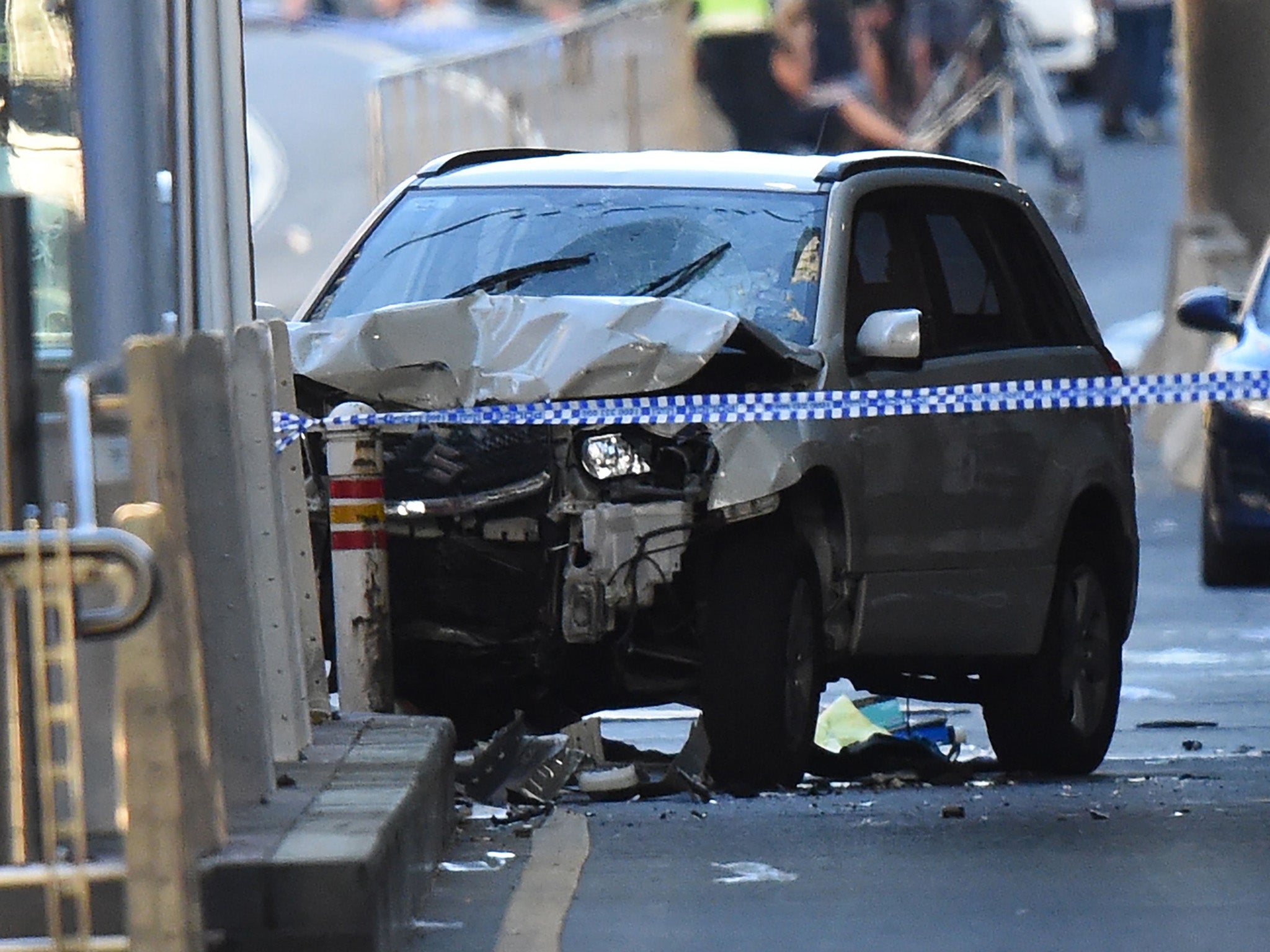Melbourne car crash: Bewilderment, resignation, and anger as city's residents take stock
Driver and a second man arrested after vehicle crashes into pedestrians

It’s all gone quiet on Flinders Street. Darkness has fallen, and normally at this time of night the streets are teeming with life: young people climbing the steps into the train station, weaving in and out of the bars and backpacker hostels and all-night chip shops. But tonight, all is still. No pedestrians, no cars; no cars but one.
On the pavement outside the train station, behind a police cordon, a smashed white Suzuki SUV is slowly being winched onto a tow truck. Above, the signal it ran through six hours earlier is still on red. A few feet away, a council works vehicle arrives with fresh bollards, to replace the ones mown down by Saeed Noori six hours earlier, along with 19 pedestrians.
This is the very heart of Melbourne, and there is an open wound across it. Flinders Street station, built in 1905, is the city’s busiest by some distance. Across from it is the popular meeting place called Federation Square, adorned with a giant Christmas tree and a large white bauble. In a few weeks’ time, when the Australian Open takes place, hundreds of people will sit and watch the tennis on a big screen. A large picture of Roger Federer looms over the thicket of police vans and flashing blue lights.
A few people are standing outside the backpackers’ hostel, taking in the scene. One of them is Rick, an archaeologist from Adelaide in town on a job. He was returning to the hostel after a meeting just up the street when he happened upon the scene of carnage. “People were just standing around, not knowing what to do,” he says. “The police had blocked off the whole street. There was lots of discarded chalk and paper along the kerb.”
He pauses, unsure whether or not to explain. “For the outlines of the bodies,” he says eventually.
Rick stood and looked. There was really very little else to be done. And what he felt was not so much the deep trauma of a victim, but the crushing emptiness of the onlooker. He brushes off all expressions of sympathy. “The guy I feel sorry for,” he says, “is this Indian guy staying in the hostel. He saw everything. He’s only been in Australia two days. He’s spent the whole night going into the hostel and coming back out again, just to look. I think he’s traumatised.”
In the minutes and hours afterwards, rumours - some entirely false, some false but based in truth - spread like contagion. At first someone said there had been 14 victims, then 19, then as many as 30. Someone said they saw two men in the car. Another eyewitness claimed to have heard gunshots. There was a rumour that after the car crashed, a crowd of people surged forward and dragged Nouri out of the car, punching and kicking him. “Yeah, I heard that one too,” Rick says, taking a drag of his roll-up cigarette. “Don’t know if there’s any truth in it.”
There is bewilderment, resignation, and anger too. At a fast-food shop on the next corner, three street cleaners are grabbing hot dogs before beginning a particularly macabre night shift. “I blame the government,” one remarks. “You go soft on these people, and this is what happens. It’s happened before, and it’ll keep on happening.”
Melbourne car crash
Show all 12In January this year, an eerily similar attack took place just a couple of blocks away, on Bourke Street. Six people were killed and 30 injured when a man driving a maroon Holden Commodore went on a joyride through central Melbourne after being refused entry to a bar, and ended up ploughing into a crowd of shoppers. Last week the driver, Dimitrious Gargasoulas, pleaded not guilty to counts of murder and attempted murder.
“You get people talking about Pauline Hanson,” one of the cleaners says, referring to the leader of the far-right One Nation party. “Well, if you had 20 Pauline Hansons in the cabinet, you think something like this would happen? They’d just shoot him on sight.”
“I’m a Kiwi, lived here 40 years,” says an older gentleman, overhearing the conversation and walking over. “Over there they’ve got the Armed Offenders. They shoot first and deal with the rest later. Everyone knows: if you try something, you get blown. And it’s probably the safest country on earth.”
But the world’s problems never got solved at half past midnight outside an all-night cafe. After a while, the conversation breaks up; the cleaners go to work on clearing fragments of twisted metal and broken glass from the surface of Flinders Street.
Life moves pretty fast in a big city. By morning, the only traces of what happened earlier will be the grim memories, the traumatic flashbacks, the harrowing camera phone footage. The police tape is coming down; people, and noise, are beginning to fill the streets again. The tow truck trundles off into the distance, carrying its deadly cargo. Above, the red traffic signal has turned green.
Subscribe to Independent Premium to bookmark this article
Want to bookmark your favourite articles and stories to read or reference later? Start your Independent Premium subscription today.

Join our commenting forum
Join thought-provoking conversations, follow other Independent readers and see their replies